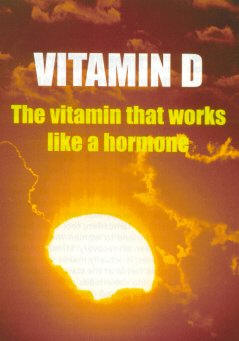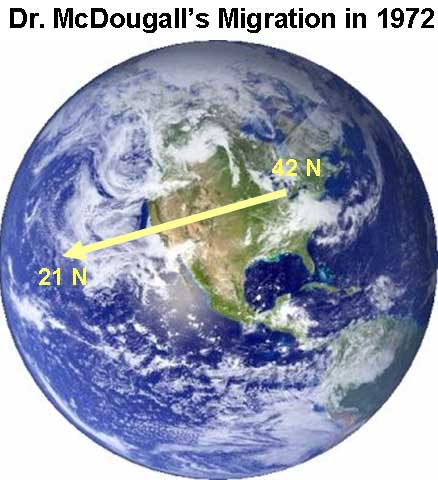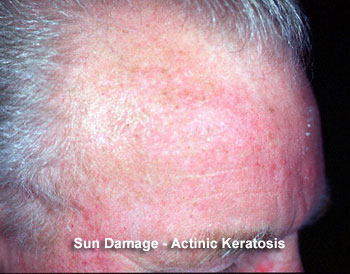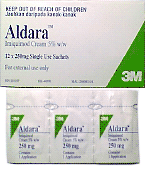Sunny Days, Keeping Those Clouds Away…
Have you ever wondered how something as natural and
omnipresent as sunlight could hurt you? Over eons of evolution (or by
Divine creation, if you choose) people have been exposed to the sun’s
radiation – you would think by now we would have adapted so as to live
in harmony with this enveloping environment. Yet, expert doctors warn
us to avoid almost any exposure to these potentially damaging rays – the
sun’s radiation is known to suppress our immune system, give us cancer,
and cause us premature aging.
However, there is a dilemma: we need this form of radiant
energy for good health – in fact, without it our bodies become diseased
with severe bone deformities (rickets). Most recently, research has
shown that without the sun’s life-giving energy we are at thirty times
greater risk of death from cancer.
Everyone feels better when the sun comes out. In
addition to the cosmetic effects of tanning – making people more
satisfied with their appearance – sunlight causes people to feel more
active , energetic, balanced, strengthened, and less nervous.1 Many people can identify with the low-sunlight, winter depression
symptoms of fatigue, lowered motivation, sleepiness,
increased appetite, weight gain, irritability, and decreased
sociability.2 Nicely summarized, sunshine is health and happiness. , energetic, balanced, strengthened, and less nervous.1 Many people can identify with the low-sunlight, winter depression
symptoms of fatigue, lowered motivation, sleepiness,
increased appetite, weight gain, irritability, and decreased
sociability.2 Nicely summarized, sunshine is health and happiness.
Sunshine Is a Potent, But Non-profitable Remedy
For centuries, doctors and natural healers relied on
medical treatment by sunlight, called Heliotherapy, to help heal
many common ailments. Scientific research shows sunshine to be an
effective treatment for rickets, osteomalacia, osteoporosis, acne,
eczema, psoriasis, neonatal jaundice, and depression (Seasonal Affective
Disorder).7-8 Most recently, solar energy has been found to prolong the life of
people with our most common forms of cancer.6-7 All considered, when was the last time you heard
of a doctor recommending an hour of afternoon sunning for a patient’s
troubles? And which pharmaceutical company sells sunshine?
| |
Health and
Healing from the Sun’s Energy3-7 |
| |
A few known
benefits of sunshine:
Lowers
cholesterol
Lowers blood pressure
Promotes thyroid stimulation
Regulates the immune system
Stimulates insulin production
Improves heart muscle contractility
Currently
prescribed for the treatment of:
Rickets
Osteomalacia
Osteoporosis
Acne
Eczema
Psoriasis
Neonatal jaundice
Depression
Has a
role in the prevention of:
Osteoporosis
Heart Disease
Type-1 diabetes
Multiple Sclerosis
Rheumatoid Arthritis
Crohn’s disease
Cancers of the: Prostate, Breast, Colon, Lung,
Ovary,
Bladder,
Uterus,
Esophagus,
Stomach,
Pancreas,
Kidney,
Multiple myeloma,
Non-Hodgkin’s lymphoma
|
| |
|
Explanations for the benefits of the sun’s energy have
focused almost exclusively on vitamin D. The truth is the therapeutic
effects from the sunlight are much broader than the simple synthesis of
this important substance. For example, the connection between sunlight
and our well being is through the increased production of the feel-good
brain chemical, serotonin.8
Motion of the sun, perceived through our eyes, from sunrise to sunset,
sets our biological clock and determines our circadian rhythms. Much is
yet to be unraveled about the mysteries and miracles of sunshine.
However, for this moment let’s focus on vitamin D.
The “Vitamin D” Connection
The main function of vitamin D is to maintain the body’s
calcium concentrations at a precise level. This is accomplished by
increasing the absorption of calcium from the intestines and the
interaction with other hormones (like parathyroid hormone). Almost all
tissues and cells in the body have receptors for this hormone, and
therefore are affected by its presence.
 More than 90% of the vitamin D requirement of people is
met by internal synthesis with the aid of sunlight, not from the diet.4 Very few foods naturally contain vitamin D. Examples are: fatty marine
fish (salmon, cod liver oil, mackerel, and sardines); and a few foods
are fortified with vitamin D, like cow’s milk sold in the United States,
as well as some orange juices, cereals, and breads – the vitamin is
added during manufacturing. Vitamin supplements (pills) are also common
sources of this active substance. More than 90% of the vitamin D requirement of people is
met by internal synthesis with the aid of sunlight, not from the diet.4 Very few foods naturally contain vitamin D. Examples are: fatty marine
fish (salmon, cod liver oil, mackerel, and sardines); and a few foods
are fortified with vitamin D, like cow’s milk sold in the United States,
as well as some orange juices, cereals, and breads – the vitamin is
added during manufacturing. Vitamin supplements (pills) are also common
sources of this active substance.
In children, vitamin D deficiency will cause a disease
characterized by the severe bone deformity called rickets. In adults,
osteomalacia (a weakening of the bones) may develop – along with muscle
weakness, and aching bones and muscles. A role for vitamin D in cancer
prevention has recently become a topic of much discussion. Since 1941
researchers have reported that common cancers, like breast, prostate,
and colon, are less common where people get more intense sunlight,
nearer the equator.7
Consumption of cow’s milk is believed to increase the
risk of aggressive and advanced cancer, especially prostate cancer, by
interfering with vitamin D activity.7 More specifically, the much-raved-about calcium
in milk suppresses circulating levels of this hormone, encouraging
cancer growth. Anticancer effects of vitamin D are: regulation of cell
growth, helping older cells die when they are supposed to (apoptosis),
inhibiting the formation of new blood vessels that feed cancers,
stopping the spread of cancer (metastasis), and helping to prevent
out-of-control cellular proliferation – a hallmark of cancer. The
benefits are not just limited to prevention – there is good evidence
that sunlight exposure can benefit those who have already been diagnosed
with cancer.7

“Vitamin D” is a misnomer. Vitamins, by definition, are
not synthesized by our body, but are small organic substances which must
be acquired through our foods. Because we easily synthesize this
biologically active substance, it is by definition a hormone – created
by the action of sunlight on plant-derived sterols circulating through
the exposed layers of our skin. Thus, it is commonly referred to as the
“sunshine vitamin,” but more correctly it should be called the “sunshine
hormone.” This hormone only becomes a “vitamin” under the unnatural
living conditions of severe sunlight deprivation. In this case, the
only available source may be diet.
The amount of this hormone needed by our bodies is very
small. The exposure of skin sufficient to cause a slight pinkness
produces vitamin D levels equivalent to 20,000 IU (as supplied by
pills). This is 100 times greater than the RDA for adults under 50
years old, and 20 times greater than the highest recommendations for
daily oral supplements.3 Vitamin D toxicity is never caused by excess
sunlight exposure. Sunscreen with an SPF of 15 or greater can reduce
vitamin D production by 95%.4
Because vitamin D is fat soluble, it is effectively
stored in the body’s own fatty tissues where it serves as a “sunshine
battery” –for later use during the darker days of winter. With obese
people, this hormone is “sucked” so successfully into the body fat that
much of it becomes essentially unavailable for future use – this is
proposed as one reason obese people have more risk of cancer.
Unquestionable Harms from Overexposure
Sunlight is a form of powerful radiation, so it should
not surprise you that there is a potential for harm. This ultraviolet
light suppresses our cancer fighting immune system and causes the
formation of free radicals which damage our cells, including their
genetic materials (DNA). Repeated, severe injuries to the skin’s elastic
structures cause it to wrinkle, an unsightly sign of aging. Years of
overexposure can lead to precancerous, actinic keratosis, and then
actual cancers – basal cell and squamous cell carcinomas. Ultraviolet
light is one of only 60 agents designated by the World Health
Organization as a human carcinogen.6
More than 1 million cases of skin cancer annually are attributed to sun
exposure. 6 This represents 55% of all cancers in the USA. Fortunately, these forms
of skin cancer are rarely fatal.
This dark side counters our love of the sun and all the
scientific evidence that substantiates its benefits – so what went
wrong?
Unnatural Living Causes the Sunshine Paradox
Three changes in our natural condition now place us in
harm’s way:
The First Man-made Change: Migration
I (John McDougall) am of Scotch-Irish decent and my skin
is fair with a very low level of pigmentation (melanin) which allows the
sun’s vital radiation to easily penetrate its outer layers. Because of
this efficiency, I can make all the vitamin D I need from as little as
five minutes of exposure to my face, hands and arms (6% to 10% of my
body) at noon, two to three times a week, while living at a latitude
similar to Detroit’s.
My sun exposure changed drastically in my mid-twenties
when I migrated from Michigan (42 N latitude) to Hawaii (21 N
latitude). As a result, I became a “white boy” living in an environment
fitted for much darker-skinned people. I sunned my body on the beach,
sailed on my boat, windsurfed, and hiked without a hat for 15 years,
often at high noon in the summer months. The result was sun damage to
my skin that I live with to this day. I also ate a high-fat, low-plant
food diet during my early years in Hawaii.
 |
Darker-skinned people – Africans, Middle-Easterners, and
some Asians, for example – can develop just the opposite problem by
migration. Living for eons in lands of intense sunshine, their skins
became heavily pigmented (lots of melanin) to block out the sun’s
powerful radiation. Over the last 400 years, millions of these people
have relocated to lands of limited sunshine, like cloudy London or to an
office building in New York City. Dark skin requires as much as 10 to
50 times the solar energy to make the same amount of vitamin D as does
fair skin.7
The consequence is too often vitamin D deficiency, which may be one
reason that blacks living in the USA have so much more internal cancer
than whites have. Deficiency in their children also causes rickets.
It is estimated that over 50% of African-Americans in the USA are at
risk of vitamin D deficiency, compared to only 5% of whites.4,7
The Second Man-made Change: Nutrition
Animal experiments reported as early as 1939 provided the
first clues about the influence of our diet on the risk of skin damage
from sunlight.9
Researchers discovered a diet high in fat increased the numbers of
ultraviolet (UV) radiation-induced skin cancers in mice. In the 1980s,
studies showed that switching from a high-fat to a low-fat diet
immediately after the ultraviolet light exposure reversed the
cancer-promoting effects of the high-fat diet.9 These findings suggested that changing a person’s diet, even after
exposure to UV light, might prevent future skin cancers, and possibly
reverse the effects of the sun’s damage.
This may surprise you, but even more than animal
(saturated) fat, polyunsaturated oils derived from vegetables (like corn
and safflower oils) are found to be the strongest promoters of skin
cancers in people and experimental animals, of any foodstuffs that we
eat.10
This danger only applies to free oils, like those found in a bottle.
Please understand that when the oil is still in its natural state, as
part of the components of the fruit or vegetable, it is perfectly safe,
and as you know, health-promoting.
The most serious warning about the sun comes from the
fear of developing the very deadly skin cancer, melanoma. This fear is
unfounded. Research clearly shows that sun exposure has little to do
with the cause of this kind of cancer – in fact, there is good evidence
that sunshine can help prevent this vicious cancer, and can even slow
its growth – doubling a patient’s chances of surviving.11,12
Melanoma is believed to be due to a diet high in fat, especially
vegetable oils, and low in fruit and vegetables.13
Even if you have skin damage, it is not too late to
change your eating habits. An experiment published in 1994 in the New England Journal of Medicine reported that people with actinic
keratosis (precancerous, dry, scaly, rough-textured patches) were able
to reduce the chances of development of new actinic (sun damage)
lesions, 3 to 6-fold, by switching from a high fat (38% of calories) to
a relatively low-fat (21% of calories) diet – this diet was also more
plentiful in plant foods.14
Furthermore, during the last 8 months of the study the incidence of skin
cancers was 10 times less in the low-fat group than the high fat
dieters.15 (The McDougall Diet is 7% to 10% fat and made of only plant foods.)
 The Third Man-made Change: Atmosphere The Third Man-made Change: Atmosphere
The intensity of the sun’s radiation delivered to our
skin is increasing because of industrial damage to our atmosphere. Of
the types of radiation emitted by the sun, ultraviolet radiation is
believed to be almost entirely responsible for the deleterious effects
sunlight can have on our systems. The amount of ultraviolet radiation
that actually reaches the earth’s surface depends on
latitude, altitude, and weather conditions, and on the amount of ozone,
water vapor, oxygen and carbon dioxide in the atmosphere. However, the
ozone layer is becoming chemically depleted because of the presence of
chlorofluorocarbons (CFCs) in the stratosphere. CFCs are used in air
conditioners, and as cleaning and spraying agents in the chemical
industry. In 1985, it was reported that there is a hole in the ozone
layer over Antarctica and there is additional evidence that ozone is being lost at nearly all
latitudes outside of the tropics.
Action for You to Take
My observations of the world affirm for me that Nature
makes few (if any) mistakes and all forms of life are supported by
natural surroundings, which exist in delicate balances. Unfortunately,
the equilibrium has been upset and in some ways sunshine has been turned
from a friend to a potential foe. Your first response must be to take
every step to put things back into balance by making adjustments to
receive the proper amount of sun you need based on your skin
pigmentation. This may mean at one extreme hours of exposure for
dark-skinned people living in low-light conditions, and at the other
extreme great efforts to minimize exposure in fair skinned people living
near the equator.
Because of the recent worsening atmospheric conditions,
especially if you are fair skinned, you may need to wear protective
clothing, avoid sun exposure during peak hours of radiation, and use
sunscreens. Use of protective agents is a must for areas of skin that
have already been damaged – commonly, your face, neck, shoulders, and
hands. However, you can still choose to increase sun exposure to
undamaged areas of skin such as your legs, abdomen and back in order to
obtain the health benefits of this radiant energy. The safest way to
benefit from the healing powers of sunlight may be to build your
exposure slowly throughout the year and to avoid burning from impulsive
intense exposures.
Regardless of skin tone, occupation, present geographic
location, or current health, a change to a low-fat, plant-based diet
(the McDougall Diet) is always recommended for better skin – the
benefits are almost limitless and there are no added costs or adverse
effects from this simple step. This kind of eating is so powerful that
it actually provides some of the same biochemical benefits as sunlight
without any of the risks.5
I do not recommend vitamin D supplements, except in those
extremely rare cases (such as confinement to a nursing home or exile to
the Arctic) where you cannot get the most reliable and beneficial
source of vitamin D – sunshine.
The components of life that provide radiant health for
you are: clean air, water, and food, adequate rest, moderate exercise
and sunshine. These are cost-free and side-effect-free. But also
profit-free, so don’t expect much outside encouragement for their
liberal use.
Effective, Scar-free Treatment for Sun-Damaged Skin
If you
develop actinic keratosis, basal cell or squamous cell
carcinomas, there is a simple, highly effective, low-cost
treatment. The cosmetic results are excellent; rare ly
leaving scars, such as would be expected following surgery. ly
leaving scars, such as would be expected following surgery.
Aldara (imiquimod)
5% cream is by prescription only, but it is
self-administered. Results are exceptionally effective –
even the cancers disappear. Cream is applied every day or
every other day until an eruption occurs (like poison oak).
The eruption heals, leaving normal skin in most cases. Only
sun-damaged cells are affected by this treatment. See
prescribing information for details.
|
References:
1) Gambichler T, Bader A, Vojvodic M, Bechara FG,
Sauermann K, Altmeyer P, Hoffmann K. Impact of UVA exposure on
psychological parameters and circulating serotonin and melatonin.
BMC Dermatol.
2002 Apr 12;2(1):6.
2) Magnusson A. Seasonal affective disorder: an
overview. Chronobiol Int. 2003 Mar;20(2):189-207.
3) Holick MF. Vitamin D: importance in the prevention of
cancers, type 1 diabetes, heart disease, and osteoporosis. Am J Clin
Nutr. 2004 Mar;79(3):362-71.
4) Holick MF. Sunlight and vitamin D for bone health and
prevention of autoimmune diseases, cancers, and cardiovascular disease. Am J Clin Nutr. 2004 Dec;80(6 Suppl):1678S-88S.
5) McCarty MF. A moderately low phosphate intake may
provide health benefits analogous to those conferred by UV light - a
further advantage of vegan diets. Med Hypotheses. 2003
Nov-Dec;61(5-6):543-60.
6) Egan KM, Sosman JA, Blot WJ. Sunlight and reduced risk
of cancer: is the real story vitamin D? J Natl Cancer Inst. 2005
Feb 2;97(3):161-3.
7) Giovannucci E. The epidemiology of vitamin D and
cancer incidence and mortality: A review (United States). Cancer
Causes Control. 2005 Mar;16(2):83-95.
8) Hoekstra R. Effect of light therapy on biopterin,
neopterin and tryptophan in patients with seasonal affective disorder. Psychiatry Res. 2003 Aug 30;120(1):37-42.
9) Black HS. Influence of dietary factors on
actinically-induced skin cancer. Mutat Res. 1998 Nov
9;422(1):185-90.
10) Harris RB, Foote JA, Hakim IA, Bronson DL, Alberts
DS. Fatty acid composition of red blood cell membranes and risk of
squamous cell carcinoma of the skin. Cancer Epidemiol Biomarkers Prev. 2005 Apr;14(4):906-12.
11) Berwick M, Armstrong BK, Ben-Porat L, Fine J,
Kricker A, Eberle C, Barnhill R. Sun exposure and mortality from
melanoma. J Natl Cancer Inst. 2005 Feb 2;97(3):195-9.
12) Christophers AJ. Melanoma is not caused by
sunlight. Mutat Res. 1998 Nov 9;422(1):113-7.
13) Millen AE, Tucker MA, Hartge P, Halpern A, Elder DE,
Guerry D 4th, Holly EA, Sagebiel RW, Potischman N. Diet and melanoma in
a case-control study. Cancer Epidemiol Biomarkers Prev. 2004
Jun;13(6):1042-51.
14) Black HS, Herd JA, Goldberg LH, Wolf JE Jr, Thornby
JI, Rosen T, Bruce S, Tschen JA, Foreyt JP, Scott LW, et al. Effect of
a low-fat diet on the incidence of actinic keratosis. N Engl J Med. 1994 May 5;330(18):1272-5.
15) Black HS. Influence of dietary factors on
actinically-induced skin cancer. Mutat Res. 1998 Nov
9;422(1):185-90.
16) Burns CA, Brown MD. Imiquimod for the treatment of
skin cancer.
Dermatol Clin. 2005 Jan;23(1):151-64, vii.
|